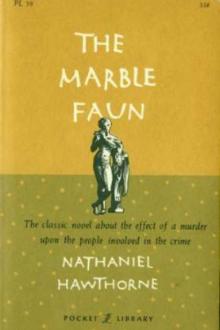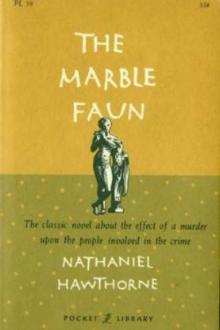The Marble Faun, vol 2 by Nathaniel Hawthorne (smallest ebook reader TXT) 📖

- Author: Nathaniel Hawthorne
- Performer: -
Book online «The Marble Faun, vol 2 by Nathaniel Hawthorne (smallest ebook reader TXT) 📖». Author Nathaniel Hawthorne
Not only at the crosses did Donatello kneel, but at each of the many shrines, where the Blessed Virgin in fresco—faded with sunshine and half washed out with showers—looked benignly at her worshipper; or where she was represented in a wooden image, or a bas-relief of plaster or marble, as accorded with the means of the devout person who built, or restored from a mediaeval antiquity, these places of wayside worship. They were everywhere: under arched niches, or in little penthouses with a brick tiled roof just large enough to shelter them; or perhaps in some bit of old Roman masonry, the founders of which had died before the Advent; or in the wall of a country inn or farmhouse; or at the midway point of a bridge; or in the shallow cavity of a natural rock; or high upward in the deep cuts of the road. It appeared to the sculptor that Donatello prayed the more earnestly and the more hopefully at these shrines, because the mild face of the Madonna promised him to intercede as a tender mother betwixt the poor culprit and the awfulness of judgment.
It was beautiful to observe, indeed, how tender was the soul of man and woman towards the Virgin mother, in recognition of the tenderness which, as their faith taught them, she immortally cherishes towards all human souls. In the wire-work screen ‘before each shrine hung offerings of roses, or whatever flower was sweetest and most seasonable; some already wilted and withered, some fresh with that very morning’s dewdrops. Flowers there were, too, that, being artificial, never bloomed on earth, nor would ever fade. The thought occurred to Kenyon, that flower-pots with living plants might be set within the niches, or even that rose-trees, and all kinds of flowering shrubs, might be reared under the shrines, and taught to twine and wreathe themselves around; so that the Virgin should dwell within a bower of verdure, bloom, and fragrant freshness, symbolizing a homage perpetually new. There are many things in the religious customs of these people that seem good; many things, at least, that might be both good and beautiful, if the soul of goodness and the sense of beauty were as much alive in the Italians now as they must have been when those customs were first imagined and adopted. But, instead of blossoms on the shrub, or freshly gathered, with the dewdrops on their leaves, their worship, nowadays, is best symbolized by the artificial flower.
The sculptor fancied, moreover (but perhaps it was his heresy that suggested the idea), that it would be of happy influence to place a comfortable and shady seat beneath every wayside shrine. Then the weary and sun-scorched traveller, while resting himself under her protecting shadow, might thank the Virgin for her hospitality. Nor, perchance, were he to regale himself, even in such a consecrated spot, with the fragrance of a pipe, would it rise to heaven more offensively than the smoke of priestly incense. We do ourselves wrong, and too meanly estimate the Holiness above us, when we deem that any act or enjoyment, good in itself, is not good to do religiously.
Whatever may be the iniquities of the papal system, it was a wise and lovely sentiment that set up the frequent shrine and cross along the roadside. No wayfarer, bent on whatever worldly errand, can fail to be reminded, at every mile or two, that this is not the business which most concerns him. The pleasure-seeker is silently admonished to look heavenward for a joy infinitely greater than he now possesses. The wretch in temptation beholds the cross, and is warned that, if he yield, the Saviour’s agony for his sake will have been endured in vain. The stubborn criminal, whose heart has long been like a stone, feels it throb anew with dread and hope; and our poor Donatello, as he went kneeling from shrine to cross, and from cross to shrine, doubtless found an efficacy in these symbols that helped him towards a higher penitence.
Whether the young Count of Monte Beni noticed the fact, or no, there was more than one incident of their journey that led Kenyon to believe that they were attended, or closely followed, or preceded, near at hand, by some one who took an interest in their motions. As it were, the step, the sweeping garment, the faintly heard breath, of an invisible companion, was beside them, as they went on their way. It was like a dream that had strayed out of their slumber, and was haunting them in the daytime, when its shadowy substance could have neither density nor outline, in the too obtrusive light. After sunset, it grew a little more distinct.
“On the left of that last shrine,” asked the sculptor, as they rode, under the moon, “did you observe the figure of a woman kneeling, with her, face hidden in her hands?”
“I never looked that way,” replied Donatello. “I was saying my own prayer. It was some penitent, perchance. May the Blessed Virgin be the more gracious to the poor soul, because she is a woman.”
CHAPTER XXXIII PICTURED WINDOWS
After wide wanderings through the valley, the two travellers directed their course towards its boundary of hills. Here, the natural scenery and men’s modifications of it immediately took a different aspect from that of the fertile and smiling plain. Not unfrequently there was a convent on the hillside; or, on some insulated promontory, a mined castle, once the den of a robber chieftain, who was accustomed to dash down from his commanding height upon the road that wound below. For ages back, the old fortress had been flinging down its crumbling ramparts, stone by stone, towards the grimy village at its foot.
Their road wound onward among the hills, which rose steep and lofty from the scanty level space that lay between them. They continually thrust their great bulks before the wayfarers, as if grimly resolute to forbid their passage, or closed abruptly behind them, when they still dared to proceed. A gigantic hill would set its foot right down before them, and only at the last moment would grudgingly withdraw it, just far enough to let them creep towards another obstacle. Adown these rough heights were visible the dry tracks of many a mountain torrent that had lived a life too fierce and passionate to be a long one. Or, perhaps, a stream was yet hurrying shyly along the edge of a far wider bed of pebbles and shelving rock than it seemed to need, though not too wide for the swollen rage of which this shy rivulet was capable. A stone bridge bestrode it, the ponderous arches of which were upheld and rendered indestructible by the weight of the very stones that threatened to crush them down. Old Roman toil was perceptible in the foundations of that massive bridge; the first weight that it ever bore was that of an army of the Republic.
Threading these defiles, they would arrive at some immemorial city, crowning the high summit of a hill with its cathedral, its many churches, and public edifices, all of Gothic architecture. With no more level ground than a single piazza in the midst, the ancient town tumbled its crooked and narrow streets down the mountainside, through arched passages and by steps of stone. The aspect of everything was awfully old; older, indeed, in its effect on the imagination than Rome itself, because history does not lay its finger on these forgotten edifices and tell us all about their origin. Etruscan princes may have dwelt in them. A thousand years, at all events, would seem but a middle age for these structures. They are built of such huge, square stones, that their appearance of ponderous durability distresses the beholder with the idea that they can never fall,—never crumble away,—never be less fit than now for human habitation. Many of them may once have been palaces, and still retain a squalid grandeur. But, gazing at them, we recognize how undesirable it is to build the tabernacle of our brief lifetime out of permanent materials, and with a view to their being occupied by future ‘generations.
All towns should be made capable of purification by fire, or of decay, within each half-century. Otherwise, they become the hereditary haunts of vermin and noisomeness, besides standing apart from the possibility of such improvements as are constantly introduced into the rest of man’s contrivances and accommodations. It is beautiful, no doubt, and exceedingly satisfactory to some of our natural instincts, to imagine our far posterity dwelling under the same roof-tree as ourselves. Still, when people insist on building indestructible houses, they incur, or their children do, a misfortune analogous to that of the Sibyl, when she obtained the grievous boon of immortality. So we may build almost immortal habitations, it is true; but we cannot keep them from growing old, musty, unwholesome, dreary,—full of death scents, ghosts, and murder stains; in short, such habitations as one sees everywhere in Italy, be they hovels or palaces.
“You should go with me to my native country,” observed the sculptor to Donatello. “In that fortunate land, each generation has only its own sins and sorrows to bear. Here, it seems as if all the weary and dreary Past were piled upon the back of the Present. If I were to lose my spirits in this country,—if I were to suffer any heavy misfortune here,—methinks it would be impossible to stand up against it, under such adverse influences.”
“The sky itself is an old roof, now,” answered the Count; “and, no doubt, the sins of mankind have made it gloomier than it used to be.” “O, my poor Faun,” thought Kenyon to himself, “how art thou changed!”
A city, like this of which we speak, seems a sort of stony growth out of the hillside, or a fossilized town; so ancient and strange it looks, without enough of life and juiciness in it to be any longer susceptible of decay. An earthquake would afford it the only chance of being ruined, beyond its present ruin.
Yet, though dead to all the purposes for which we live to-day, the place has its glorious recollections, and not merely rude and warlike ones, but those of brighter and milder triumphs, the fruits of which we still enjoy. Italy can count several of these lifeless towns which, four or five hundred years ago, were each the birthplace of its own school of art; nor have they yet forgotten to be proud of the dark old pictures, and the faded frescos, the pristine beauty of which was a light and gladness to the world. But now, unless one happens to be a painter, these famous works make us miserably desperate. They are poor, dim ghosts of what, when Giotto or Cimabue first created them, threw a splendor along the stately aisles; so far gone towards nothingness, in our day, that scarcely a hint of design or expression can glimmer through the dusk. Those early artists did well to paint their frescos. Glowing on the church-walls, they might be looked upon as symbols of the living spirit that made Catholicism a true religion, and that glorified it as long as it retained a genuine life; they
 Reading books romantic stories you will plunge into the world of feelings and love. Most of the time the story ends happily. Very interesting and informative to read books historical romance novels to feel the atmosphere of that time.
Reading books romantic stories you will plunge into the world of feelings and love. Most of the time the story ends happily. Very interesting and informative to read books historical romance novels to feel the atmosphere of that time.




Comments (0)